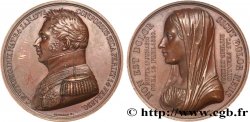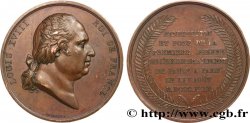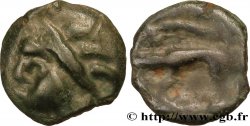fme_704260 - LOUIS XVIII Médaille, Mariage du duc de Berry
120.00 €(Approx. 136.80$ | 102.00£)
Quantity
Add to your cart

Type : Médaille, Mariage du duc de Berry
Date: 1816
Metal : bronze
Diameter : 49,5 mm
Orientation dies : 12 h.
Engraver ANDRIEU Jean-Bertrand (1761-1822)
Weight : 66,50 g.
Edge : lisse
Puncheon : sans poinçon
Coments on the condition:
Jolie patine marron, avec quelques traces de manipulation dans les champs et des taches noires, notamment sur la tranche. Présence de coups et rayures
Catalogue references :
Predigree :
Cet exemplaire provient de la collection Terisse
Obverse
Obverse legend : LVDOVICVS. XVIII - REX CHRISTIANISSIMVS..
Obverse description : Tête à droite de Louis XVIII. Signé : ANDRIEU F..
Reverse
Reverse legend : SPES. ALTERA. REGNI. // À L’EXERGUE CAR. FERDINANDA. SICILIARVM. REG IS. NEPTIS / CAROLO. FERDINANDO. BITVRIGVM. DVCI / LVDOVICI. XVIII. FR. F. NVPTA / D. XVII. IVN. A. MDCCCXVI. .
Reverse description : Un ange de face tient deux couronnes, l'une inscrite CAROLVS/ FERDIN au-dessus d'un flambeau, l'autre inscrite CAROLINA/ FERDIN au-dessus d'un autel.
Commentary
Médaille d’époque, sans poinçon sur la tranche.
Charles-Ferdinand d’Artois, duc de Berry, né à Versailles le 24 janvier 1778 et mort assassiné à Paris le 13 février 1820, est un prince de la maison de Bourbon. Il est le fils de Charles-Philippe de France, comte d’Artois (futur « Charles X »), et de Marie-Thérèse de Savoie.
Marie Caroline Ferdinande Louise de Naples et de Sicile, duchesse de Berry puis comtesse Lucchesi Palli et duchesse della Grazia, est née à Caserte en 1798 et morte au château de Brunnsee près de Mureck en Styrie en 1870.
Épouse de Charles Ferdinand d'Artois, duc de Berry, fils de Charles X, elle est la mère du « comte de Chambord » Henri d'Artois, prétendant légitimiste au trône de France sous le nom de « Henri V ».
Au nom de son fils le « comte de Chambord », elle tenta en vain de prendre le pouvoir en France en 1832 en qualité de « régente ».
Charles-Ferdinand d’Artois, duc de Berry, né à Versailles le 24 janvier 1778 et mort assassiné à Paris le 13 février 1820, est un prince de la maison de Bourbon. Il est le fils de Charles-Philippe de France, comte d’Artois (futur « Charles X »), et de Marie-Thérèse de Savoie.
Marie Caroline Ferdinande Louise de Naples et de Sicile, duchesse de Berry puis comtesse Lucchesi Palli et duchesse della Grazia, est née à Caserte en 1798 et morte au château de Brunnsee près de Mureck en Styrie en 1870.
Épouse de Charles Ferdinand d'Artois, duc de Berry, fils de Charles X, elle est la mère du « comte de Chambord » Henri d'Artois, prétendant légitimiste au trône de France sous le nom de « Henri V ».
Au nom de son fils le « comte de Chambord », elle tenta en vain de prendre le pouvoir en France en 1832 en qualité de « régente ».








 Report a mistake
Report a mistake Print the page
Print the page Share my selection
Share my selection Ask a question
Ask a question Consign / sell
Consign / sell
 Full data
Full data










